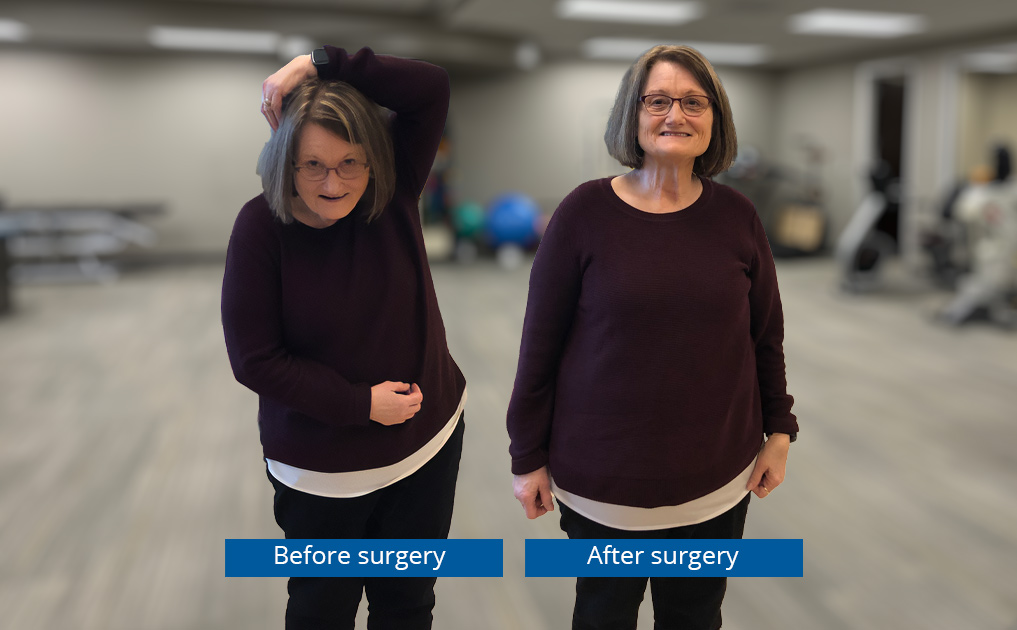
Dora's story
Herniated disc, radiculopathy
Spine surgery helps Dora lower her pain level – and her left arm
To relieve the pain and numbness, Dora started walking and sitting with her left arm extended up in the air, above her head. It was the only way she could function.
"I still had pain, but holding my arm that way relieved it enough that it was tolerable," she said.
The symptoms had started in Dora's shoulders, then into her neck and finally down her left arm – all the way to her hand. Eventually, she started to lose strength in her arm and hand.
"I couldn't hold a cup in my left hand without worrying about it falling," Dora says.

Dora was experiencing symptoms that are common for those suffering a herniated disc, when the gel-like substance leaks out from between the vertebrae and impinges on nearby nerves. When the nerves are affected enough, patients can experience numbness and tingling into their extremities. In severe cases, they can lose strength in the arm or leg, signaling a significant problem that may require spine surgery to repair the damage.
Dora had suffered some arm and neck pain years before. Last summer, she was on vacation with her grandchildren when she noticed the pain down into her shoulders. "The next day," she said, "I could barely get up."
Dora said eventually, the muscles in her arm started to atrophy. For four months, Dora could not drive at all, and her only activity was going to a couple of youth soccer games and doctor appointments. For relief, she would either cradle her left arm or hold it up in the air.
That's when Dora's family physician sent her to Mayfield Brain & Spine. She had some epidural steroid injections, which provided only temporary relief. In Dora's next visit to the Green Township office, nurse practitioner Gina Malott walked down the hall to consult with neurosurgeon Dr. Lauren Ostling, who came in to talk to Dora.
"When she (Malott) found out everything that was going on, she expedited the process," Dora recalled. "Before I left the office, she had Dr. Ostling look it over."
Dr. Ostling told Dora that the surgery could relieve her symptoms, but it would take time to regain her strength and motion.
"She emphasized the trust we need with each other," Dora said. "She was going to do her part, and I was going to have to do my part."
Dr. Ostling immediately recognized the disc herniations at the C6-C7 levels in Dora's neck, and the impact it was having on Dora's daily life.
"When Dora was holding up her left arm, it was the only position that would relieve some of the pressure on the nerves in her cervical spine," Dr. Ostling said. "The damaged disc had spilled out into the spinal canal and was pushing on the nerve. Severe pressure on those nerves often causes this same set of symptoms, which eventually can lead to a loss of strength down the arm. It was a clear sign that surgical intervention was necessary."
To relieve the pain and numbness on Dora's left side, and to stop the loss of strength, Dr. Ostling performed an anterior cervical discectomy and fusion, known as ACDF. She removed the disc between the C6 and C7 levels, at the base of Dora's neck, which had spilled out and affected the nearby nerves. Then she fused the surrounding vertebrae together.
Immediately after the surgery, Dora's most severe symptoms were gone – the pain down the left arm, the numbness and tingling in her hand. Within a few weeks, she had started physical therapy, which is helping to rebuild the strength in her arm.
"I feel like a new person," she said. "I feel like I got my life back."
~ Cliff Peale
Hope Story Disclaimer -"Dora's Story" is about one patient's health-care experience. Please bear in mind that because every patient is unique, individual patients may respond to treatment in different ways. Results are influenced by many factors and may vary from patient to patient.
